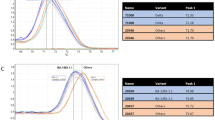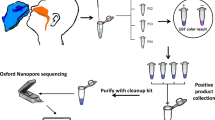Abstract
Background
The accurate and expeditious detection of SARS-CoV-2 mutations is critical for monitoring viral evolution, assessing its impact on transmission, virulence, and vaccine efficacy, and formulating public health interventions. In this study, a detection system utilizing micro temperature gradient gel electrophoresis (μTGGE) was developed for the identification of the D614 and G614 variants of the SARS-CoV-2 spike protein.
Methods
The in vitro synthesized D614 and G614 gene fragments of the SARS-CoV-2 spike protein were amplified via polymerase chain reaction and subjected to μTGGE analysis.
Results
The migration patterns exhibited by the D614 and G614 variants on the polyacrylamide gel were distinctly dissimilar and readily discernible by μTGGE. In particular, the mid-melting pattern of D614 was shorter than that of G614.
Conclusions
Our results demonstrate the capability of μTGGE for the rapid, precise, and cost-effective detection of SARS-CoV-2 spike protein D614 and G614 variants without the need for sequencing. Therefore, this approach holds considerable potential for use in point-of-care mutation assays for SARS-CoV-2 and other pathogens.




Similar content being viewed by others
Data availability
All data are available in case of need.
Change history
25 April 2024
A Correction to this paper has been published: https://doi.org/10.1007/s11033-024-09348-1
Abbreviations
- CCM:
-
Chemical cleavage of mismatch
- COVID-19:
-
Coronavirus disease
- DGGE:
-
Denaturing temperature gel electrophoresis
- DHPLC:
-
Denaturing high-performance liquid chromatography
- HA:
-
Heteroduplex analysis
- μTGGE:
-
Micro temperature gradient gel electrophoresis
- PCR:
-
Polymerase chain reaction
- PTT:
-
Protein truncation test
- SARS-CoV-2:
-
Severe acute respiratory syndrome coronavirus 2
- SSCP:
-
Single-strand conformation polymorphism
- ssDNA:
-
Single-stranded DNA
- TGGE:
-
Temperature gradient gel electrophoresis
- T m :
-
Melting temperature
References
Liu YC, Kuo RL, Shih SR (2020) COVID-19: the first documented coronavirus pandemic in history. Biomed J 43:328–333. https://doi.org/10.1016/j.bj.2020.04.007
Andersen KG, Rambaut A, Lipkin WI, Holmes EC, Garry RF (2020) The proximal origin of SARS-CoV-2. Nat Med 26:450–452. https://doi.org/10.1038/s41591-020-0820-9
Plante JA, Liu Y, Liu J, Xia H, Johnson BA, Lokugamage KG, Zhang X, Muruato AE, Zou J, Fontes-Garfias CR, Mirchandani D, Scharton D, Bilello JP, Ku Z, An Z, Kalveram B, Freiberg AN, Menachery VD, Xie X, Plante KS, Weaver SC, Shi PY (2021) Spike mutation D614G alters SARS-CoV-2 fitness. Nature 592:116–121. https://doi.org/10.1038/s41586-020-2895-3
Gazali FM, Nuhamunada M, Nabilla MR, Supriyati E, Hakim MS, Arguni E, Daniwijaya EW, Nuryastuti T, Haryana SM, Wibawa T, Wijayanti N (2021) Detection of SARS-CoV-2 spike protein D614G mutation by qPCR-HRM analysis. Heliyon 7:e07936. https://doi.org/10.1016/j.heliyon.2021.e07936
Meng Q, Wang X, Wang Y, Dang L, Liu X, Ma X, Chi T, Wang X, Zhao Q, Yang G, Liu M, Huang X, Ma P (2021) Detection of the SARS-CoV-2 D614G mutation using engineered Cas12a guide RNA. Biotechnol J 16:e2100040. https://doi.org/10.1002/biot.202100040
Crossley BM, Bai J, Glaser AL, Maes RK, Porter E, Killian ML, Clement T, Toohey-Kurth KL (2020) Guidelines for sanger sequencing and molecular assay monitoring. J Vet Diagn Investig 32:767–775. https://doi.org/10.1177/1040638720905833
Mardis E (2017) DNA sequencing technologies: 2006–2016. Nat Protoc 12:213–218. https://doi.org/10.1038/nprot.2016.182
Eren K, Taktakoğlu N, Pirim I (2022) DNA sequencing methods: from past to present. Eurasian J Emerg Med 54:47–56. https://doi.org/10.5152/eurasianjmed.2022.22280
Sloan DB, Broz AK, Sharbrough J, Wu Z (2018) Detecting rare mutations and DNA gamage with sequencing-based methods. Trends Biotechnol 36:729–740. https://doi.org/10.1016/j.tibtech.2018.02.009
Strathdee F, Free A (2013) Denaturing gradient gel electrophoresis (DGGE). Methods Mol Biol 1054:145–157. https://doi.org/10.1007/978-1-62703-565-1_9
Pasookhush P, Usmani A, Suwannahong K, Palittapongarnpim P, Rukseree K, Ariyachaokun K, Buates S, Siripattanapipong S, Ajawatanawong P (2021) Single-strand conformation polymorphism fingerprint method for dictyostelids. Front Microbiol 12:708685. https://doi.org/10.3389/fmicb.2021.708685
Kakui H, Yamazaki M, Shimizu KK (2021) PRIMA: a rapid and cost-effective genotyping method to detect single-nucleotide differences using probe-induced heteroduplexes. Sci Rep 11:20741. https://doi.org/10.1038/s41598-021-99641-x
Tabone T, Sallmann G, Cotton RG (2009) The chemical cleavage of mismatch for the detection of mutations in long DNA fragments. Methods Mol Biol 578:223–234. https://doi.org/10.1007/978-1-60327-411-1_14
Hauss O, Müller O (2007) The protein truncation test in mutation detection and molecular diagnosis. Methods Mol Biol 375:151–164. https://doi.org/10.1007/978-1-59745-388-2_8
Colasuonno P, Incerti O, Lozito ML, Simeone R, Gadaleta A, Blanco A (2016) DHPLC technology for high-throughput detection of mutations in a durum wheat TILLING population. BMC Genet 17:43. https://doi.org/10.1186/s12863-016-0350-0
Ruchika TT, Biyani M (2020) A nonsequencing approach for the rapid detection of RNA editing. J Vis Exp 182:e63591. https://doi.org/10.3791/63591-v
Agarwal T, Komazaki S, Sharma H, Biyani M (2014) Rapid and molecular discrimination of host-specific fungal plant pathogens in pulse crops using genome profiling. Curr Sci 107:1704–1710
Kumari P, Gautam SG, Baba M, Tsukiashi M, Matsuoka K, Yasukawa K, Nishigaki K (2017) DNA-based mutation assay GPMA (genome profiling-based mutation assay): reproducibility, parts-per-billion scale sensitivity, and introduction of a mammalian-cell-based approach. J Biochem 162:395–401. https://doi.org/10.1093/jb/mvx043
Biyani M, Yasukawa K (2022) A non-sequencing approach for rapid RNA testing of SARS-CoV-2 variants using RICCA and PalmPAGE system. J IEIE Jpn 42:109–112. https://doi.org/10.14936/ieiej.42.109
Dwight D, Palais R, Wittwer CT (2011) uMELT: prediction of high-resolution melting curves and dynamic melting profiles of PCR products in a rich web application. Bioinformatics 27:1019–1020. https://doi.org/10.1093/bioinformatics/btr065
Nishigaki K, Saito A, Takashi H, Naimuddin M (2000) Whole genome sequence-enabled prediction of sequences performed for random PCR products of Escherichia coli. Nucleic Acids Res 28:1879–1884. https://doi.org/10.1093/nar/28.9.1879
Biyani M, Nishigaki K (2001) Hundredfold productivity of genome analysis by introduction of microtemperature-gradient gel electrophoresis. Electrophoresis 22:23–28. https://doi.org/10.1002/1522-2683(200101)22:1%3c23:AID-ELPS23%3e3.0.CO;2-Z
Acknowledgements
We acknowledge Ms. Emi Arikawa and Mr. Masayuki Yamagata for technical assistance.
Funding
This work was supported in part by Grants-in-Aid for Scientific Research (no. 23KJ1201 for K.J., no. 18KK0285 for T.T. and K.Y., 18K19839 for M.B. and K.Y., and no. 22H03332 for T.T. and K.Y.) from Japan Society for the Promotion of Science, Emerging/re-emerging infectious disease project of Japan (grant no. 20he0622020h0001 for T.T. and K.Y. and 23hk0302011h0203 for M.B. and K.K.) from Japan Agency for Medical Research and Development, and A-Step (no. JPMJTR20UU for K.Y.) from Japan Science and Technology Agency.
Author information
Authors and Affiliations
Contributions
KMJ, MB, and KY designed the research; KMJ, KM, VS, KS, RS, MB, KY performed the research; KMJ, MB, TT, and KY analyzed data; KMJ, MB, and KY wrote the manuscript.
Corresponding authors
Ethics declarations
Conflict of interest
Authors declare that they have no conflict of interests.
Research involving human and animal rights
No experiment was conducted on animals in this study.
Consent for publication
All authors agree for publication.
Additional information
Publisher's Note
Springer Nature remains neutral with regard to jurisdictional claims in published maps and institutional affiliations.
The original online version of this article was revised: The figure 1 has been corrected.
Rights and permissions
Springer Nature or its licensor (e.g. a society or other partner) holds exclusive rights to this article under a publishing agreement with the author(s) or other rightsholder(s); author self-archiving of the accepted manuscript version of this article is solely governed by the terms of such publishing agreement and applicable law.
About this article
Cite this article
Juma, K.M., Morimoto, K., Sharma, V. et al. Detection of SARS-CoV-2 spike protein D614G mutation using μTGGE. Mol Biol Rep 51, 289 (2024). https://doi.org/10.1007/s11033-023-09065-1
Received:
Accepted:
Published:
DOI: https://doi.org/10.1007/s11033-023-09065-1




